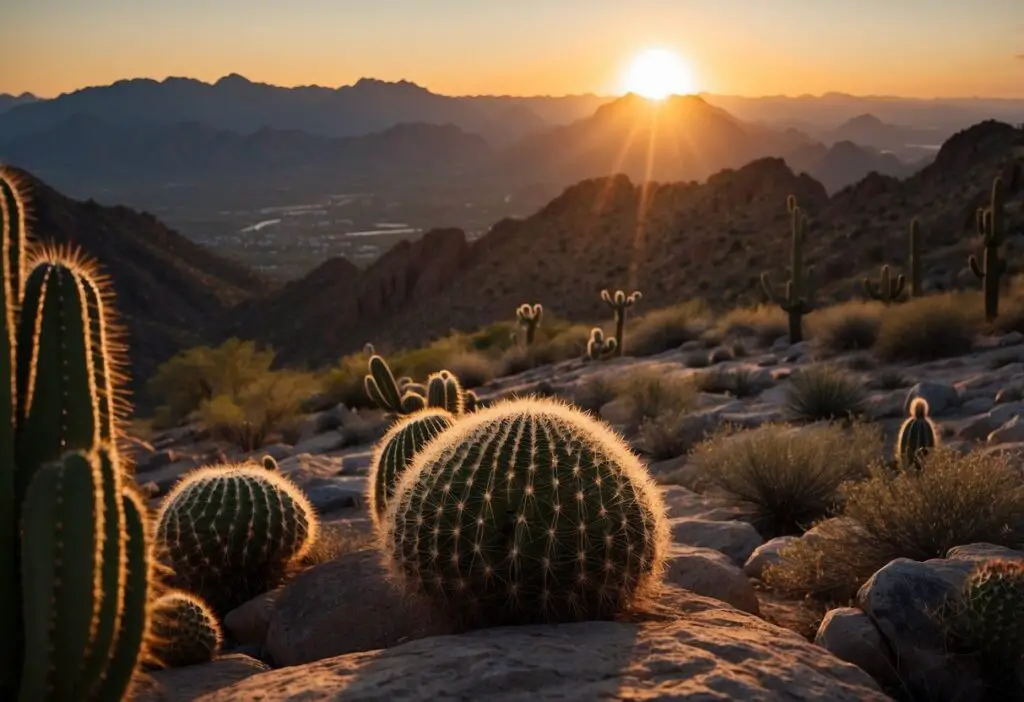Nestled within the vibrant city limits of Phoenix, Arizona, the Piestewa Peak Recreation Area offers an enticing blend of natural beauty and challenging trails. Hikers and nature enthusiasts flock to this spot to enjoy panoramic 360-degree views of the city and surrounding landscape. With its notable elevation and diverse flora and fauna, it’s a must-visit for anyone looking to immerse themselves in the desert environment.

Visitors to Piestewa Peak can explore miles of trails, ranging from easy walks to more strenuous climbs. One of the highlights includes the Summit Trail, which rewards climbers with breathtaking views from the top. Not just a haven for hikers, this recreation area also welcomes runners and families looking for a picturesque outdoor experience.
Convenience is key for visitors, as the park provides amenities such as restrooms and water stations. Those planning to hike should bring plenty of water and be prepared for the rugged terrain. Whether you’re aiming for the summit or simply enjoying the serene atmosphere, Piestewa Peak Recreation Area promises a memorable adventure.
Key Takeaways
- Piestewa Peak Recreation Area offers beautiful trails and panoramic city views.
- The Summit Trail is a popular and rewarding hike.
- The park provides essential amenities for a comfortable visit.
History and Significance

Piestewa Peak has a rich history and cultural significance, marked by its name and the tribute to Lori Ann Piestewa. The following highlights the key aspects of its history and significance.
Naming and Renaming
Originally known as Squaw Peak, Piestewa Peak received its current name in 2003. The name change was made to honor Lori Ann Piestewa, the first Native American woman to die in combat during the Iraq War.
Squaw Peak was a name considered offensive by many due to its derogatory connotation towards Native American women. This renaming was part of a broader effort to acknowledge and respect indigenous cultures and contributions.
Lori Piestewa Tribute
Lori Ann Piestewa was born in Tuba City, Arizona, part of the Navajo Reservation. She served in the Iraq War and became the first woman of the Hopi tribe and the first Native American woman to die in combat during the conflict.
The renaming of the peak in her honor acknowledges her bravery and sacrifice. In addition to the peak, the area also includes a memorial ramada and trail, providing a place for reflection and remembrance.
Geography and Landscape

Piestewa Peak recreation area is part of the scenic Phoenix Mountains and offers a unique experience with its varied terrain and natural beauty. The area showcases impressive elevation changes and ecological features characteristic of the Sonoran Desert.
Phoenix Mountains Overview
Piestewa Peak is part of the Phoenix Mountains, a range that also includes Camelback Mountain. This peak reaches an elevation of 2,608 feet, making it the second-highest point in the range. The surrounding landscape includes mountains and valleys, creating a rugged terrain. This area is also close to major roads like the Piestewa Freeway, facilitating easy access for visitors. The mountains mainly consist of schist, a type of metamorphic rock, which gives the terrain its unique appearance and texture.
Ecological Features
The Sonoran Desert’s ecology heavily influences the area around Piestewa Peak. You’ll find desert plants like saguaro cacti, creosote bushes, and palo verde trees. These plants are adapted to the hot, arid conditions. Wildlife is also abundant, including coyotes, jackrabbits, and various bird species. The desert landscape includes sandy areas, rocky outcrops, and secluded valleys that provide diverse habitats for these species. The multi-use trails in the area offer opportunities for visitors to explore these natural features up close. They can witness the intricate balance of plant and animal life that thrives in this ecosystem.
Recreational Activities
Piestewa Peak offers a variety of recreational activities, making it a popular destination for outdoor enthusiasts. Key activities include hiking on multiple trails and other outdoor ventures like picnicking and wildlife observation.
Hiking at Piestewa Peak
Hiking is a major attraction at Piestewa Peak. The most popular trail is the Piestewa Peak Summit Trail, which offers a challenging hike with steep climbs and rocky terrain. The trail is about 1.2 miles long and provides stunning views of the city from the top.
For those looking for a less intense experience, the Freedom Loop Trail and Circumference Trail are excellent options. These trails offer moderate difficulty and take hikers around the base of the peak. Restrooms and drinking water are available at the trailheads. The trails are well-marked, making navigation easy even for beginners.
Other Outdoor Activities
Besides hiking, Dreamy Draw Recreation Area offers several other outdoor activities. Picnicking is a popular choice, with designated areas providing tables and grills in a serene desert setting. Visitors can enjoy views of the desert flora, including saguaros and ocotillos.
The recreation area also has spots for bird watching due to the various species that inhabit the region. Cycling is another activity, with paved trails that cater to both casual and serious bikers. The presence of such diverse options makes Piestewa Peak and its surrounding areas a perfect spot for enjoying the natural beauty and getting away from city life.
Flora and Fauna

Piestewa Peak Recreation Area is home to a wide variety of desert plants and animals. The diverse ecosystem offers intriguing opportunities for nature enthusiasts to observe unique flora and fauna.
Desert Plants
Piestewa Peak showcases a rich assortment of desert vegetation. The towering Saguaro cacti stand out with their iconic shapes, often spotted alongside Barrel cacti with their stout and rounded forms. Hedgehog cacti, known for their clusters of spiky stems, add to the variety.
Prickly Pear cacti are easily identifiable with their flat, pad-like segments. Ocotillo plants bloom with vibrant red flowers in the spring, their spindly, stick-like stems reaching skyward. Low-lying bushes like Creosote and Mesquite trees provide essential shade and habitat for many desert creatures.
In spring, this plant community comes alive with wildflowers, splashing the landscape with colors. These plants are well-adapted to the arid conditions, making them a fascinating study for those interested in desert ecosystems.
Wildlife Encounters
Visitors to Piestewa Peak might encounter various desert animals. Reptiles such as Chuckwallas are a common sight, often basking on sun-drenched rocks. These large lizards are known for their ability to inflate their bodies to wedge themselves into crevices for protection.
Birds also thrive in the area, with numerous species such as hawks, owls, and hummingbirds. The Mesquite trees provide nesting sites and food sources.
Mammals like coyotes, desert cottontails, and occasionally bobcats can be spotted, especially in the early morning or late evening hours. Each encounter offers a glimpse into the adaptability and resilience of wildlife in the harsh desert environment.
Visitor Amenities

Piestewa Peak offers several amenities to ensure a comfortable and safe hiking experience. Visitors will find parking options, water stations, and clear guidelines to keep everyone safe.
Parking and Access
Parking at Piestewa Peak is available in multiple lots. The main parking area is on East Squaw Peak Drive, just past the entrance gate. Early arrival is recommended, as these lots can fill up quickly, especially on weekends. Overflow parking is also available, but consider carpooling to reduce congestion.
Dogs are allowed but must be kept on a leash. There are designated dog-friendly areas and waste disposal stations for convenience. Ensure you bring enough water as the Phoenix Mountains Park area can get extremely hot. Water fountains are provided at the trailheads for refilling bottles.
Safety and Regulations
Safety is a top priority at Piestewa Peak. Hikers are advised to wear appropriate footwear and sun protection due to the desert terrain. Stay on marked trails to prevent accidents and avoid disturbing the natural habitat.
The Phoenix Parks and Recreation Department has set clear regulations to ensure a safe experience. Signs are posted throughout the Phoenix Mountains Preserve, reminding visitors of rules like no littering and staying on paths. Fire restrictions may be in place during dry seasons, so always check for updates before your visit.
Conservation Efforts

Efforts at Piestewa Peak focus on preserving the natural ecosystem and engaging the community. These initiatives are crucial to maintaining the area’s beauty and biodiversity.
Preservation Initiatives
At Piestewa Peak, conservation is a priority. The Arizona Sustainability Alliance collaborates with the Central Arizona Conservation Alliance to monitor and manage invasive plant species. These projects map and remove invasive plants to support native growth.
Habitat preservation is another focus. Various native Sonoran trees and plants thrive here, which trail users can observe. This helps maintain the local ecosystem, providing shelter and food for wildlife. Additionally, efforts are made to keep trails clean and minimize human impact, ensuring the area’s natural beauty is preserved for future generations.
Community Involvement
Community engagement is a cornerstone of conservation at Piestewa Peak. Volunteers participate in citizen science projects to map and remove invasive species. These activities not only manage plant populations but also educate participants about local ecology.
Events and volunteer programs by organizations like Phoenix Parks and Recreation offer locals hands-on conservation experiences. These activities deepen community connections to Piestewa Peak, promoting a culture of care and responsibility. By involving residents in conservation, these programs foster a shared commitment to preserving the area’s natural resources.
Challenges and Considerations

Visitors to Piestewa Peak should be aware of several challenges related to the area’s environmental impact and managing visitor traffic. These aspects are crucial for preserving the natural habitat and ensuring a safe and enjoyable experience for all.
Environmental Impact
The high number of visitors to Piestewa Peak can lead to significant environmental stresses. The trails experience continuous wear and tear, especially given the area’s steep elevation gain. This can result in soil erosion, which negatively affects plant life and disrupts the habitat of local wildlife.
In areas without shade, the trail soil can become more compacted and dry. This makes it challenging for vegetation to survive. Another concern is litter, which can harm animals and pollute the local ecosystem. It’s important for visitors to stay on marked paths and carry out all trash.
Managing Visitor Impact
Crowding is one of the biggest challenges at Piestewa Peak. Weekends and holidays often see a surge in visitors, leading to packed trails and full parking lots. This can make the already difficult and extremely difficult sections of the hike even more challenging.
To mitigate these issues, it is helpful for hikers to visit during off-peak times, such as weekdays or early mornings. Additionally, there are ongoing efforts to upgrade trail maps and signage to better manage the flow of hikers and reduce congestion. To maintain a cooperative atmosphere, hikers are encouraged to yield to others on narrow paths, especially where the trail becomes steep.
By following these guidelines and being mindful of their surroundings, visitors can help preserve the beauty and sustainability of Piestewa Peak while enjoying its many recreational opportunities.
Planning Your Visit

Piestewa Peak offers scenic trails and wonderful views, making it a top destination for outdoor enthusiasts. To make the most of your visit, consider the ideal times to go and what essentials to bring.
Best Times to Visit
Visiting Piestewa Peak is best in the cooler months. From October to April, the temperatures are more comfortable for hiking. Summer can be extremely hot, with temperatures often exceeding 100°F, making hiking dangerous. Early mornings or late afternoons are also good to avoid the midday heat.
Weekdays and early mornings are great for avoiding crowds. The Summit Trail can be quite busy, especially on weekends. For a quieter experience, consider exploring trails during off-peak hours.
Sunday mornings can also be a bit busy, but less so than Saturdays. The trails are open year-round, and each season offers unique views and experiences.
What to Bring
When hiking Piestewa Peak, it’s important to bring adequate water. The dry desert climate can dehydrate you quickly, especially on longer trails like the Freedom Loop Trail. Bring at least 1-2 liters of water per person.
Sturdy hiking shoes are essential due to the rocky terrain. A hat and sunscreen are also advised to protect against the intense Arizona sun. It’s wise to bring snacks for energy, particularly for longer hikes.
A map or GPS device can be helpful. While the trails are well-marked, it’s easy to lose your way.
Don’t forget your camera or smartphone to capture the stunning views from the peak. These essentials will ensure you have a safe and enjoyable visit.
Nearby Attractions

Visitors to Piestewa Peak can find a wealth of nearby attractions both in the bustling Phoenix Metropolitan Area and in the surrounding natural landmarks.
Phoenix Metropolitan Area
The Phoenix Metropolitan Area offers a variety of attractions for all interests. For nature enthusiasts, Camelback Mountain stands out as a major draw. With its steep trails and panoramic city views, it provides a challenging and rewarding hike.
Dreamy Draw Recreation Area, accessible from Piestewa Peak, is another favorite. It offers trails for hiking and biking in a scenic desert landscape. The Echo Canyon Trail at Camelback Mountain also provides a rugged experience with stunning rock formations and city views.
For those interested in history and culture, the Phoenix Art Museum and the Heard Museum offer extensive collections of art and Native American artifacts. The Desert Botanical Garden showcases the diverse plant life of the Sonoran Desert, making it an educational and tranquil spot to visit.
Other Natural Landmarks
In addition to Piestewa Peak, the surrounding area features a number of natural landmarks worth exploring. North Mountain and Iron Mountain offer less crowded trails for hiking and bird-watching.
The Freedom Trail, a loop that circles Piestewa Peak, is perfect for those seeking a moderate hike with great views of the peak and surrounding desert.
For more extensive outdoor adventures, the Superstition Mountains east of Phoenix provide dramatic landscapes, rich history, and a variety of trails ranging from easy to very challenging.
Closer to the city, the White Tank Mountains and South Mountain offer scenic drives, hiking trails, and picnic areas. South Mountain is particularly known for its stunning sunset views over the Phoenix skyline.
These natural landmarks provide diverse outdoor activities, from leisurely walks to challenging hikes, ensuring there’s something for everyone to enjoy.
Frequently Asked Questions

Piestewa Peak Recreation Area offers stunning views and challenging trails. This section covers operating hours, trail difficulty, parking, camping, trail expectations, and a comparison with a nearby hike.
What are the operating hours for Piestewa Peak Recreation Area?
Piestewa Peak Recreation Area is open daily from sunrise to sunset. It’s important to plan your hike accordingly to ensure you have enough time to complete your journey within the operating hours.
What is the difficulty level of the hiking trails at Piestewa Peak?
The trails at Piestewa Peak are considered challenging. The Piestewa Peak Summit Trail, for instance, is steep and rocky, making it suitable for experienced hikers. Another popular trail, the Piestewa Peak and Freedom Loop Trail, is also marked as difficult and takes an average of 3 hours and 17 minutes to complete.
Where can visitors find parking when heading to Piestewa Peak?
Visitors can find parking at multiple trailheads within the recreation area. It is advisable to arrive early, especially on weekends and holidays, as the parking lots can get crowded quickly.
Are there any camping facilities available at Piestewa Peak Recreation Area?
There are no camping facilities at Piestewa Peak Recreation Area. Visitors should plan for day trips only. For camping, other areas in the Phoenix Mountain Preserve or nearby camping sites outside the city might be considered.
What should hikers expect from the Piestewa Peak Nature Trail?
The Piestewa Peak Nature Trail offers no shade. The temperature of the mountain’s stone can reach up to 150 degrees Fahrenheit. Hikers should bring plenty of water and plan for an early start to avoid the intense midday heat. The trail is rocky and requires proper footwear.
How does the Piestewa Peak hike compare in difficulty to the Camelback Mountain hike?
The Piestewa Peak hike and the Camelback Mountain hike are frequently compared due to their similar peak elevation and trail distance. Both are challenging, but each hike offers unique views and experiences. It’s best to assess your fitness level and prepare accordingly for either trail.






